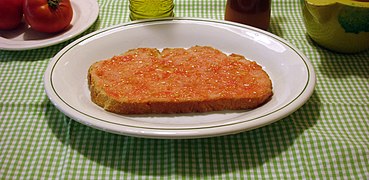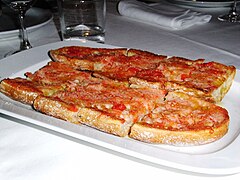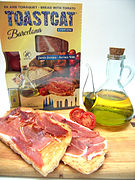Pa amb tomàquet
 Pa amb tomàquet | |
| Type | Tapas, snack |
|---|---|
| Place of origin | Catalonia |
| Region or state | Catalonia, Balearic Islands, Aragon, Roussillon |
| Invented | 1800s |
| Main ingredients | Bread, tomato, olive oil |
Pa amb tomàquet (Catalan pronunciation: [ˈpa m tuˈmakət]); also known as pan con tomate (both meaning "bread with tomato") outside of Catalonia, is a traditional food of Catalan, Aragonese and Balearic cuisine. Pa amb tomàquet is considered a staple of Catalan cuisine and identity.
It consists of bread, which may or may not be toasted, with tomato rubbed over and seasoned with olive oil and salt.
It is considered one of the typical examples that define the Mediterranean diet, extended as a traditional recipe throughout the Catalan Countries, and its preparation has become an iconic ritual of Catalan culture.
It is popularly consumed on its own as a snack, as sandwich or a tapa with any meal, from breakfast to dinner.[1][2]
Preparation
[edit]

In some Catalan restaurants, the tomato is spread on the bread, while others provide the guests with the ingredients to do the work themselves.[3] The dish is served accompanied with any sorts of sausages (cured botifarres, xoriço, fuet, Iberian ham, etc.), ham, cheeses, omelettes, anchovies or other marinated fish, or grilled vegetables like escalivada.
In Majorca, pa amb oli ("bread with oil") is prepared with tomato called Tomàtiga de Ramellet, a specific variety of vine tomatoes, smaller and with a taste that is slightly more intense and sour than normal tomatoes due to the loss of acidity in the tomato.[4]
The original base used to be made with toasted slices of pa de pagès ("peasants' bread"), a typical round loaf of wheat bread of a fair size (from 500 to 5,000 g or 1 to 11 lb, from some 20 to 50 cm or 8 to 20 in in diameter).
If the mixture is not pre-made, there is said to be an ideal order in which the ingredients are integrated to yield the best flavour. First, if used, the garlic is rubbed on the bread. Then the same is done with the tomato. Next comes the salt, and lastly the olive oil.
History
[edit]The origin of this dish is disputed, as tomato is relatively new to Catalan cuisine (it came from America only after the 15th century). Widely regarded as the epitome of Catalan cuisine and identity, some sources claim it is actually a relatively recent (mid to late 19th century) in all the Mediterranean coast of Spain.
Catalan chef Josep Lladonosa i Giró says it was first documented in the 18th century.[5] The cook, born in 1938, remembers his grandmother explaining that her parents used to eat a dish called pa amb tomàquet.[5] With better precision, Catalan cooking historian Nèstor Luján says that the first written reference is from 1884 and, according to his thesis, the recipe would have been created in the rural world during an abundant tomato harvest. People would have used the tomatoes to soften hard and dry bread.[5]
The dish shares some similarities with the tomato and olive oil-rubbed ħobż biz-Zejt of Malta, with the pan-bagnat of Nice, in the Provence region of France, the tomato-topped version of Italian bruschetta.
Gallery
[edit]-
Pa amb tomàquet
-
Tray of pa amb tomàquet
-
With ham (pernil)
-
With olives
-
With anchovies
-
Fried sonsos with pa amb tomàquet
-
Pa amb tomàquet packaged kit
-
Adding olive oil
-
Squeezed tomato after use
See also
[edit]References
[edit]- ^ Virbila, S. Irene (17 July 2014). "For tomato season: Catalonia's pa amb tomàquet". Los Angeles Times. Retrieved 19 April 2017.
- ^ "The sacred principles of "pa amb tomàquet"". Barcelonaturisme.com. Retrieved 19 April 2017.
- ^ "Pa Amb Tomàquet (Catalan Tomato Bread)". Food & Wine. Retrieved 9 October 2024.
- ^ "Tomàtiga de Ramellet: The most Mallorcan of tomatoes - INPALMA.COM". Palma Daily. 10 March 2016. Archived from the original on 7 November 2018. Retrieved 19 April 2017.
- ^ a b c La cuina tradicional catalana a l'abast, pg. 96, Josep Lladonosa i Giró, 2005, Columna Cuina, ISBN 84-664-0666-2
External links
[edit]- Pa amb tomaquet Group on Flickr
- Pomés, Leopoldo (1994). Teoría y práctica del Pa amb tomàquet (in Spanish). Barcelona: Tusquets Editores. ISBN 978-84-7223-772-8.









